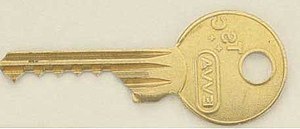What Is a Bump Key?
Most people think a locked door affords them security, but to anyone who knows how to use a bump key, a door lock is just a minor inconvenience.
Bump keys are keys cut to a special design that will allow them to be used for picking pin-tumbler locks. Pin-tumbler locks are the world’s most popular lock and these include exterior door entry locks for homes. The process of gaining entry using a bump key is called “bumping’, and it can be very effective.
All the cuts on a bump key are made to the maximum depth, so any key blank can be made into a bump key. Bump keys are manufacturer-specific. So, a full set of bump keys would include one for each of the major lockset manufacturers.

How Do They Work?
Keys operate by aligning tiny spring-loaded pins inside the lock. Once the pins are correctly aligned, the cylinder will turn and the lock can be operated.
To use a bump key, the “pull-back” method is common. With this method, the key is inserted all the way in, and then pulled back out one notch. While keeping rotational pressure on the key, it is then bumped into the keyway with the heel of the hand or with a device of some sort.
The “bumper” need to bump the key hard enough to jar the pins, but not so much that the lock or key is damaged. Bumping the key causes the pins to jump slightly. Even this slight amount of motion is enough to allow the bump key to turn the cylinder, unlocking the lock.
Another method for using a bump key, called “minimal movement,” is slightly more sophisticated than the pull-back method. Bump-key performance can be improved by filing away an additional 0.25 to 0.5 mm from the key tip and shoulder, allowing the key to be inserted slightly farther into the lock.
How Effective Are Bump Keys?
The success of the bumper depends on practice. Very little skill is required, and the learning curve is short. Success will also vary with the type of lock and quaity of the key. Keys made from soft metal won’t last long. Bumping tends to work better on more expensive locks, since the hard, high-quality parts work more smoothly.
Bump keys sometimes deform when they’re hit causing them to jam in the keyway. They can be difficult to remove.
How Can I Tell If a Lock Has Been Bumped?
You can sometimes spot a lock that has been opened with a bump key if you see a small indentation just above the keyway. Some older, softer locks will have dents even though they have not been bumped.
It’s also possible to make bump keys that are protected from leaving indentations. You may be able to tell that a lock has been bumped, but don’t count on it.


